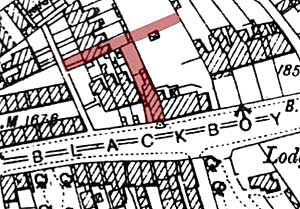
Bowling Green
Page updated 4th May 2014
Bowling Green Official Website
 The Bowling Green is located in Blackboy Road, which was also known as the Bath Road, as it was on the main route out of Exeter for stage coaches heading to Bath. The house dates back to an active rope makers which was established in the late 18th Century.
The Bowling Green is located in Blackboy Road, which was also known as the Bath Road, as it was on the main route out of Exeter for stage coaches heading to Bath. The house dates back to an active rope makers which was established in the late 18th Century.
The earliest listing as a rope makers on the site is from 1791, when it was run by James Hill, who originated from Sandford, Devon. His son James (2) married Maria Woof, a woman from St Sidwell, in 1808. In 1822, he was declared bankrupt, and the Flying Post published his petition to be allowed to continue his business, stating “Your Petitioner has a wife, and four children under the age of thirteen, and is deprived of all means of supporting them, except from the benevolence of his fellow-citizens, to enable him to resume his business, as a twine spinner."
His wife, Maria ran the rope makers after the bankruptcy, before their son James (3) took over, and in 1830 he purchased the property 30 Black Boy Road, located next door. A cottage fronted the road, and he applied for a beer house license. His daughter Elizabeth, married Alfred James Donohue in 1859, and lived briefly at her father’s. He had been a soldier with the 8th Hussars, and was one of the trumpeters who sounded the advance for the famous Charge of the Light Brigade, at Balaclava, Crimea.
A plan for a St Sidwell's feoffee shows the land for the rope makers at the rear. The base of the T is the frontage on the road, and the long crossed section at the rear is the ropewalk, where the strands that make up the rope were laid, and twisted into rope. It is probable that the Hill’s ropewalk was contained in a long timber shed.
In June 1898, by order of the mortgagee, the Ropemakers Arms was for auction; Mr James Wilcocks Hill (4) was in possession, and must have fallen behind with his payments. Thus, the last of a long line of the Hill family vacated the premises, and in 1900, the new owner rebuilt the premises, although according to the report, the changes did not improve the facilities for drinkers. In 1902 the license was transferred from Mr C Morgan to Mr W C Chambers. Then in 1908 from Chambers to Mr J Whensley.
The pub was named the Bowling Green, in December 1987, probably due to its proximity to the Exeter Bowling Club green opposite, rather than any association with Sir Francis Drake. The pub sign shows Drake playing his famous game of bowls, before he embarked his ship to fight the Spanish in the Armada. On July 18, 1588, he was playing a game on Plymouth Hoe when he was informed of the approach of the Spanish Armada. He said "We still have time to finish the game and to thrash the Spaniards, too."
The modern Bowling Green often has live music, and a quiz night, as well as providing food.
1839 - Hill, James, Black boy road - Robson's
1844 - Hill Jas. rope maker, Hampton buildgs, Black Boy road - Pigot's
1850 - Hill James, Black Boy road - beerhouse, White's. Also listed under Rope & Twine maker.
1858 - Hill, J., ropemaker, Blackboy-road
- West of England Pocket Journal
1878 - 29-30 Hill Mrs S. rope, &c. maker - Whites
1898 - James Wilcocks Hill
vacted as the premises were auctioned
1902 - Mr C Morgan to Mr W C Chambers
1908 - Mr Chambers to Mr J Whensley
1912 - Ropemakers' Arms, Whensley, J., 29 and 30, Blackboy rd - Kelly's
1923 - 29 & 30 Whensley Jn. beer ret - Post Office
1927 - Mr Whensley died and the license transferred to Alma his widow
1934 - Ropemakers' Arms, Field, S., 29 and 30, Blackboy rd - Besley's
1939 - 29 & 30 Ropemakers' Arms P. H. Chas Miller - Kellys
1940 - Mr Charles Miller
to Mr R A Doncaster
1956 - Ropemakers' Arms Inn, Fredk. J. Nicholls, 29/30 Blackboy rd - Kelly's
 The Bowling Green public house.
The Bowling Green public house.  The site of the ropemakers
was a T shape, with the ropewalk across the top.
The site of the ropemakers
was a T shape, with the ropewalk across the top.
│ Top of Page │